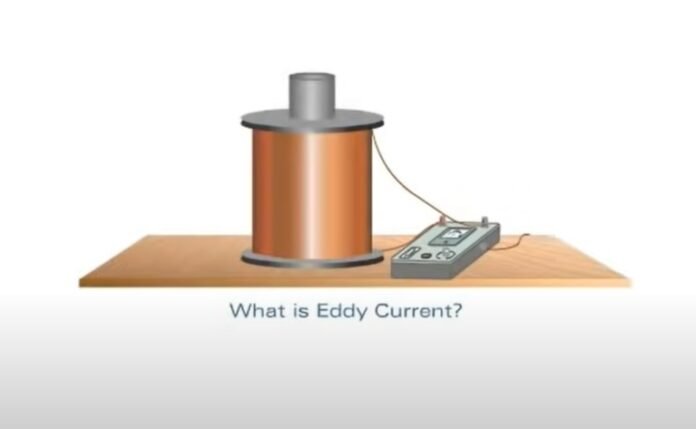Introduction
Due to the current’s resemblance to eddies or whirlpools, eddy currents are so termed. Eddy current has been the name for the induced current that forms in a conductor when it’s exposed to a magnetic field that changes. As per Faraday’s law of induction, eddy currents are electrical current loops that have been induced in only conductors by a fluctuating magnetic field well within the conductor. In conductors, eddy currents move into closed loops in directions opposite to the magnetic field.
What Causes Eddy Currents?
Eddy currents were produced whenever a conductor moves through a magnetic field or if the magnetic field shifts around over a static conductor. Eddy currents may consequently form if a conductor experiences a change in the direction or even intensity of a magnetic field.
According to Lenz’s law, an induced current’s direction would have resembled that of an eddy current because the magnetic field it generates will defy the shifting magnetic field it generates.
- Proportional to the strength of the magnetic field
- Associated with magnetic flux variation
- In the opposite direction of the conductor’s resistance.
Eddy currents tend to neutralise any fluctuations in the magnetic field which cause them, which lead a conductor to lose energy. These turn electrical or physical energy, for example, into heat. We use the eddy currents created by the resistance the opposite magnetic fields create to halt rotating machinery, especially roller coasters.
How are Eddy Currents Used?
Eddy currents offer a lot of real-world applications in addition to being fun for experiments, bragging to your friends, and making YouTube movies.
Roller coasters use eddy currents as part of their electromagnetic braking systems to slow the carriages, so if you’ve ever been on one, you’ve probably seen them in action. There is no mechanical wear because there is no contact with the brake shoes and drums.
Vending machines also use eddy currents to spot fake currency. Behind the dazzling facade is a whole universe of science at work when you insert a penny.
When a fake coin is inserted into a machine, it passes a magnet as well, unlike genuine coins; because it is constructed of conductive, it is slowed down and put into a rejection shoot by the eddy currents it generates.
Eddy currents are used in material testing, arguably their most significant application. Eddy currents can also detect damage or cracked material because fissures in a material’s surface prevent eddy currents from developing in the damaged area. Especially helpful if you’re crafting something like aeroplane wings!
Eddy Currents In Braking Systems
Consider the braking system of a train and roller coaster passing by a stationary magnet. The magnetic field becomes quite strong as the sheet stretches far beyond the magnet’s left edge, and counterclockwise eddy currents start to form over on the sheet’s top. According to Lenz’s law, Magnetic drag would’ve been produced whenever the sheet left the magnetic field so at the opposite edge of the magnet because currents will create a magnetic field that was perpendicular to the surrounding magnetic field.
Eddy currents would move in a clockwise direction or even a magnetic field could act downward as a result of the opposite-direction field shift. The drag effect will cause this to attract an external magnet to itself. These drag forces generate the braking action within the sheet by slowing the moving sheet. External magnets were frequently replaced with internal ones. Simple adjustments to the current passing through the electromagnet’s coil can change the braking force. Eddy braking has no mechanical wear and tear because it is contactless.
Recommended Articles:
What Are Energy Bands?
What Is Force Types Of Forces And Their Nature
Internet History of the internet Overview & Timeline
What is Nuclear Fission? Definition, Pros and Cons
PRESBYOPIA—Nearsightedness: Symptoms, Diagnosis, and Treatment
A moving magnet, for instance, will experience a drag force that opposes its speed when it comes in contact with a nearby conductive surface because eddy currents are created in the surface by the moving magnetic field. Eddy current brakes, used to stop rotating power equipment when switched off swiftly, utilise this phenomenon. They circulate in closed loops perpendicular to the magnetic field plane and are produced by shifting magnetic fields. They take place whenever a conductor moves through a magnetic field or when the magnetic field of a conductor that is stationary changes. Some applications, such as Magnetic braking in trains: In some electrically driven trains, powerful electromagnets are positioned above the rails. Eddy currents created in the rails when the electromagnets are turned on prevent the train from moving. Tests using eddy currents have certain limitations. Magnetic permeability is susceptible to small changes, making it challenging to test welds and other ferromagnetic materials. Suitable only for conductive materials: Only materials that permit the flow of electrical current can be measured using an eddy current. What are Eddy Currents? Definition, Used and Systems FAQs
Explain Eddy currents with examples.
What brings about eddy current?
What are the benefits of eddy current?
What is eddy current's biggest drawback?
